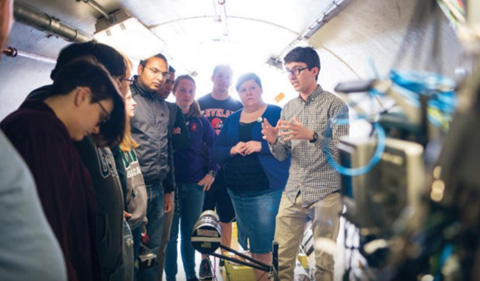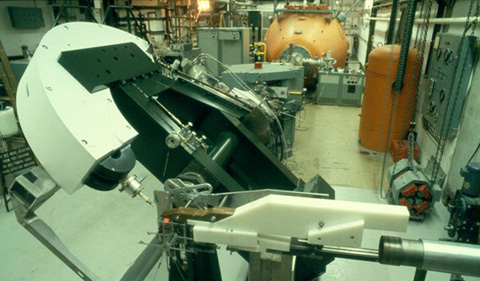Dr. Adam Fritsch, associate professor of physics at Gonzaga University, joins Ohio University as a Robert and Rene Glidden Visiting Professor in the Physics & Astronomy Department for the academic year 2021-22.
Fritsch will spend his sabbatical at OHIO working closely with Associate Professor Zach Meisel and other researchers at the Edwards Accelerator Laboratory, where he will explore adding a cutting-edge detection capability called a time projection chamber.
“Dr. Fritsch also has significant expertise in physics education and will be helping us to reimagine the undergraduate laboratory courses in the physics department,” said Dr. David Ingram, professor and department chair.
“The Glidden professorship enables OHIO and Gonzaga University (a top 20% physics school) to form research and teaching linkages that will last well beyond this year. We look forward to hosting nuclear physics experiments and undergraduate research projects by Gonzaga students in the future,” Ingram added.
Adding Time Projection Chamber Capabilities to Edwards Accelerator Lab
Fritsch’s primary research focus is the cluster structure of atomic nuclei, wherein a nucleus appears to be well represented as a collection of nucleons. In particular, α-particle (helium nuclei) cluster structures play a key role in nuclear structure and nuclear astrophysics. The most famous example of this cluster structure is the so-called Hoyle state in carbon-12, which is essential for the evolution of stars and the existence of life itself.
To date, Fritsch’s primary experimental approach has involved the use of time-projection chambers. These are cutting edge nuclear physics devices that are responsible for much of the recent high-impact science coming out of modern nuclear physics facilities. Fritsch played a key role in the development of the Active Target Time Projection Chamber and its prototype, located at the Facility for Rare Isotope Beams at Michigan State University. More recently, he has expanded his research portfolio to include the design of γ-ray (gamma ray) arrays for nuclear physics studies.
“While at Ohio University, Dr. Fritsch will explore opportunities to use the Active Target Time Projection Chamber and a large gamma-ray detector array at the Edwards Accelerator Laboratory. Each of these devices would expand the laboratory’s capabilities by introducing complementary detector technology to the existing repertoire,” Meisel said.
“It’s called a time projection chamber because it records a two-dimensional projection of a particle’s path within the detector and uses time information to reconstruct the three-dimensional path that is needed to extract physics information,” he added.
Fritsch and Meisel also will collaborate closely with Dr. Alexander Voinov, a research associate professor at OHIO, on studying the statistical properties of atomic nuclei with measurements performed at the Edwards Lab.
Rethinking Undergraduate Courses, Which are Already Upside Down
The Physics & Astronomy Department has been known for its creative approach to curriculum, being among the first to adopt the inverted classroom—also known as the flipped classroom—where students in some courses do hands-on and group activities during class with a minimum of lecture and a lot of homework reading and preparation.
“There is an old joke that the lecture format is the fastest way to transfer the professor’s notes to the student’s notes without going through the head of either one,” said Ingram, noting that the department has employed a “force-concept inventory” and student surveys to measure student learning. “Professor Fritsch’s expertise as an educator will provide a unique opportunity during his visit as a Glidden professor to help update and enhance our undergraduate curriculum.”
Fritsch brings significant experience in undergraduate education, having taught 10 different types of undergraduate physics courses, ranging from advanced courses for undergraduate physics majors to introductory physics lectures and laboratory classes for nonmajors. He has actively developed his teaching pedagogy through numerous professional development pursuits.
As a graduate student, Fritsch was awarded a competitive FAST Fellowship from Michigan State University to participate in a year-long mentored teaching program. As a faculty member, Fritsch has participated in over a dozen workshops on physics teaching. Examples include: incorporating computational physics into the undergraduate curriculum, a number of ALPhA (Advanced Laboratory Physics Association) training sessions on enhancing undergraduate laboratory courses, and strategies to emphasize diversity and inclusion in the physics curriculum.
“I believe that exposing students to topics such as the conservation laws of nature makes introductory courses more rewarding for the students and the teachers,” said Fritsch, who teaches physics courses to students from all majors at Gonzaga. He also moderates the Physics Journal Club, where students and faculty from across campus discuss fascinating news from the physics community.
About the Robert and Rene’ Glidden Visiting Professorship: This program supports short-term academic appointments for distinguished visitors to Ohio University. The purpose of the Professorship is to expose Ohio University students and faculty to outstanding individuals, and make such individuals aware of the strengths and resources of Ohio University. Glidden Professors are expected to be distinguished individuals who have attained wide recognition based upon their artistic, engineering, historical, literary, or scientific achievement.






















Comments